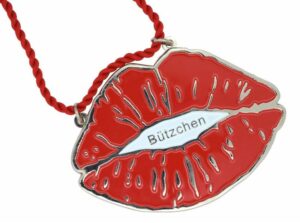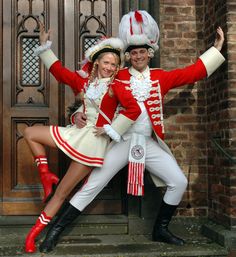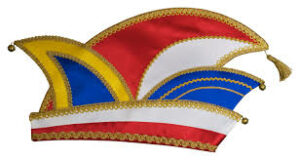Whether you call it Fasching, Fastelovend or Karneval, her is a bit of the fool's lexicon where you will find the many facets of historical customs and current meanings around our beloved 5th Season.
There are well over 100 terms, to express regional peculiarities (such as masks and costumes) in Germany and around the world, So we can only scratch the surface. For the seasoned fools who wants to learn more about the different customs there is a German link here.
Because of its ancient traditions, Karneval has preserved a vocabulary that would otherwise have fallen victim to the German language’s natural selection.Some phrases are old dialect versions of medieval greetings, to be screamed across swarms of costumed revelers, others are archaic names for specific things. Here is a cross-section, with our explanations.
Helau! – Düsseldorf’s Karneval greeting, used in many places including Koblenz and Mainz and the Phoenix Club (the Anaheim KG has strong roots in Mainz).It is either derived from “Hallelujah” or “Hello.”
Alaaf! – A Karneval greeting inthe Cologne dialect. Like all Karneval greetings, it originates from trying to say something else while inhibited with drink. In this case, it is an alcoholic derivative of “alles ab” or “everything gone,” but can be used to mean “Cologne above all else” in Köllealaaf! Context provides meaning. There is a pronounced rivalry between the left bank Cologne and other regions. Therefore, the Karneval novice should beware that in Cologne and the surrounding area, hastily calling out "Helau" is frowned upon.
Ahoi! – Actually, "ahoy" is an old sailor salute, which has also found in the course of time entrance into the everyday German language. In northern Germany and parts of the Pfalz, "ahoi" also forms a salutation during Karneval. This is the North German alternative to the widespread " Helau "and the Kölsche" Alaaf ".
Büttenrede – A rhyming speech mainly given during the variety shows known as Karnevalssitzungen. The Bütte, which actually means a barrel, is also the lectern from which they are delivered. The tradition, like everything else Karneval-related, is old Christian, harking back to a time when the Büttenrede was used to utter blasphemies punishable by maiming any other time of year. Germans often like to mark festive occasions with rhyming couplets. Büttenrede can be very sharp witted and political, but should be taken as harmless jokes.
Bund Deutscher Karneval – The League of German Karneval acts as an umbrella organization of the German Karneval clubs . It forms the top of a multi-level structure of regional and regional associations in which the clubs are organized. About 4800 clubs are members here.
In practice, the Bund Deutscher Karneval has devoted itself above all to traditional customs and the promotion of young talent. In addition, the association organizes the "German Championship in Karneval Dance Sport", runs the German Karneval Museum and awards its own cultural prize.
 Bütze/Bützchen – Especially in Cologne, revelers not only distribute "Kamelle" (candy) , but also Bützchen. (A kiss) represented by a pucker with pursed lips.
Bütze/Bützchen – Especially in Cologne, revelers not only distribute "Kamelle" (candy) , but also Bützchen. (A kiss) represented by a pucker with pursed lips.
Such a kiss can be presented on numerous occasions, for example, via air from the carriages of the Karneval parades, or a peck during Weiberfastnacht. In general, this kiss is nothing more than a friendly-happy gesture - without any romantic or erotic intentions.
Elferrat – In today's Karneval clubs, the Elferrat has mainly organizational tasks. For example, this group (usually consisting of more than eleven people) is planning the Karneval sessions, parades and other events. In the majority of traditional clubs, the Elferrat consists exclusively of men. In some clubs women are also allowed or provide their own advice.
Historically, the Elferrat also has a political dimension. The Elf (eleven) is not only a foolish number, derived from the official beginning of Karneval on 11.11., But also stands for the motto of the French revolution ("liberty, equality, fraternity"), E for Egalité, L for Liberté and F for Fraternité (whereby the order of the words was changed to spell ELF).
When the left bank of the Rhine in Germany was occupied by Napoleon's troops at the beginning of the 19th century, the citizens (among all the restrictions) were give more political freedom. Those freedoms once again gave way, with the military defeat of France, and the Prussian restoration. The Elferrat was in this sense a commitment to the lost "democratic" rights - and under the guise of Karneval foolishness.
 Funkenmariechen or Tanzmariechen – The Funkenmariechen is indispensable from the Karneval events. The young girls and women provide lively and at times acrobatic dance interludes as entertainment. In earlier times it was the men that danced. Since the 1920s, the Tanzgarde (dance guards) have been predominantly women.
Funkenmariechen or Tanzmariechen – The Funkenmariechen is indispensable from the Karneval events. The young girls and women provide lively and at times acrobatic dance interludes as entertainment. In earlier times it was the men that danced. Since the 1920s, the Tanzgarde (dance guards) have been predominantly women.
Originally the Funkenmariechen was an invention of the Rhenish Karneval, but then spread in other areas of Central Europe, where Karneval is celebrated. The visual model for today's dancing girls was the so-called 18th century Marketenderinnen - women who accompanied military troops in various capacities. Accordingly, the traditional costume of the girls and women (with uniform jacket and tricorne hat) has military flair. Short skirt, tights, and ruffle underwear,on the other hand, emphasize the feminine component and an irreverence for military decorum.
Tanzmariechen don't only perform solo, but also with partners (dance officers or dance guards). In addition to polka and march music, the dancers are sometimes accompanied by more modern sounds.
Gürzenich – A beautiful late gothic hall (1441 to 1447) in Cologne. The Gürzenich is the venue for events of the Cologne Karneval clubs. There are five rooms with a maximum capacity of 1,338 seats.
Throughout Germany, the Gürzenich is known by television broadcasts of the WDR ,which records a carnival session from the Großen Festsaal (Great Hall). It is organized annually by the "Gemeinnützige Gesellschaft des Kölner Karnevals mbH". In addition, a variety of other Karneval events such as the Prinzenproklamation are held here.
Jeck – In Rhenish lands - and sometimes beyond - a friend of Fasching or Karneval is called a Jeck. In other regions of Germany, on the other hand, there is less talk of Jecken, and more of "Narren".
The Jeck does not only like to celebrate Karneval - in a broader sense, he is also a humorous person who likes to enjoy Karneval-style fun. There is a subtle difference between the Jeck and the "Karnevalist": A Karnevalist is part of the organized Karneval, for example, by playing a club function or performing in public - while Jecken simply enjoys celebrating along side.
Lecker Mädche – Hot chick/delicious girl in the Cologne dialect. Not strictly a Karneval-related term, but one that is often used and happily accepted as a harmless compliment at this traditional event.
Lumpenball – The rag ball, or ragged ball, is a variety of masked ball . Unlike traditional Karneval costumes, visitors to a rag ball are challenged to wear conspicuously worn and ragged clothing. Violations of this "dress code" are frowned upon.
The origin of the event's theme of playing with the principles of beauty allegedly comes from Vienna. The first rag ball was organized there in 1872. Our rag ball closes our season, where we partied to the point of rags and leftovers.
Mardi Gras – the French name for the Karneval and is translated as "fat Tuesday". The name comes from the rich and fatty foods that are eaten on the last day before Ash Wednesday in preparation for the austerity during Lent . The original name for this Tuesday has been transferred over time to the entire Karneval period.
Mardi Gras is celebrated colorfully and cheerfully not only in Catholic France, but also in other francophone regions of the world. This includes the east of Canada as well as New Orleans, Louisiana.
Morgestraich – A nocturnal parade held in Basel, Switzerland, one of the few Karneval towns with a Protestant history. On Carnival Monday at 4 o'clock in the morning, the BaselFasnacht begins with the "Morgestraich": At this kick-off event, the Fasnachtscliquen come together (carnival guilds) in the center of Basel and march with fife and drum. This tradition began as early as 1835. During the Morgestraich the whole city center douses it's lights, including the shop-window lighting. The parade carries oversized lanterns for lighting and most participants wear small head lanterns.
 Narrenkappe – A fool's cap. It is usually made of durable fabric, has several bright colors and is sometimes decorated with bells. A typical, widely used fool's cap has three points and mimics the shape of a cockscomb.
Narrenkappe – A fool's cap. It is usually made of durable fabric, has several bright colors and is sometimes decorated with bells. A typical, widely used fool's cap has three points and mimics the shape of a cockscomb.
The "Hahnenkamm" is a traditional attribute of a "fool" and did not mean anything good in the fifteenth century: the rooster, like the fool succumbs to carnal lust, and is far from the love of God. Donkey ears were also added to jester caps of this time, which symbolized stupidity and laziness, among other things.
The cap has been a fashionable mark of the Karneval fool, since the early 19th century. In 1827 Karnevalists were required to wear a fool's cap in Cologne Karneval . The caps were still made of paper at that time and were burned publicly at the end of a session. Nowadays they accompany the members of a carnival club for many years.
Narrenrufe – The collective term for the many Karneval greetings liable to be barked at you out on the streets. Alaaf! and Helau! are the most common, because they come from the two biggest Karneval cities, but there are almost as many variations on “Hello” as there are Karneval towns. Literally, a Narrenruf is the cry of an idiot.
Narrensprung – The Fool’s Leap, a traditional procession of leaping fools in the town of Rottweil.
Quetschenbüggel – This Dr. Seussian word is an old Rhineland term for a concertina. If you are not fond of jolly concertina music, Karneval is no place for you.
 Rosenmontag – Rose Monday is the pinnacle of Karneval, especially in Rhenish areas. It is the Monday before Ash Wednesday. In many Karneval strongholds the largest and most important parades take place on this day and are known as the - Rosenmontagszüge. Many companies release their employees so they can participate in the hustle and bustle. Not only in Cologne, but also in Dusseldorf, Mainz and other cities, there is a kind of state of emergency on the streets and in the pubs/restaurants.
Rosenmontag – Rose Monday is the pinnacle of Karneval, especially in Rhenish areas. It is the Monday before Ash Wednesday. In many Karneval strongholds the largest and most important parades take place on this day and are known as the - Rosenmontagszüge. Many companies release their employees so they can participate in the hustle and bustle. Not only in Cologne, but also in Dusseldorf, Mainz and other cities, there is a kind of state of emergency on the streets and in the pubs/restaurants.
Rose Monday has had a few changes in its traditional name. In 1822, a festival committee was founded, which had the task of giving the Rhenish Karneval a new image in times of Prussian absolutism. From that time, this celebration committee met once a year on the Monday after the so-called "Rose Sunday". Rose Sunday, was named for the golden rose annually consecrated by the pope, on the fourth Sunday in pre-Easter Lent. Later, the name Rosenmontag was transferred to the current date (four weeks earlier, just before Lent). Rose Monday always takes place 48 days before Easter Sunday. The earliest date possible on calendar is 2 February, the latest date is 8 March. This year it is March 4th. A long Karneval season!
S' goht degege! – An obscure old-German saying, deriving from “Es geht dagegen!” (it goes against…) Whether it means against a wall or your principles, fools take comfort in the fact that after the season, is also before the season!
Zunft – Another word for a Karnevalsverein, the clubs and societies that organize Karneval events.